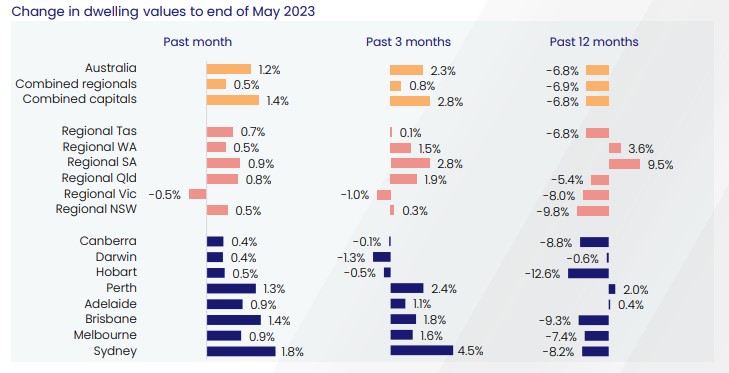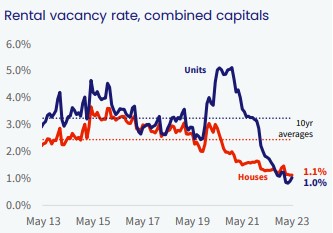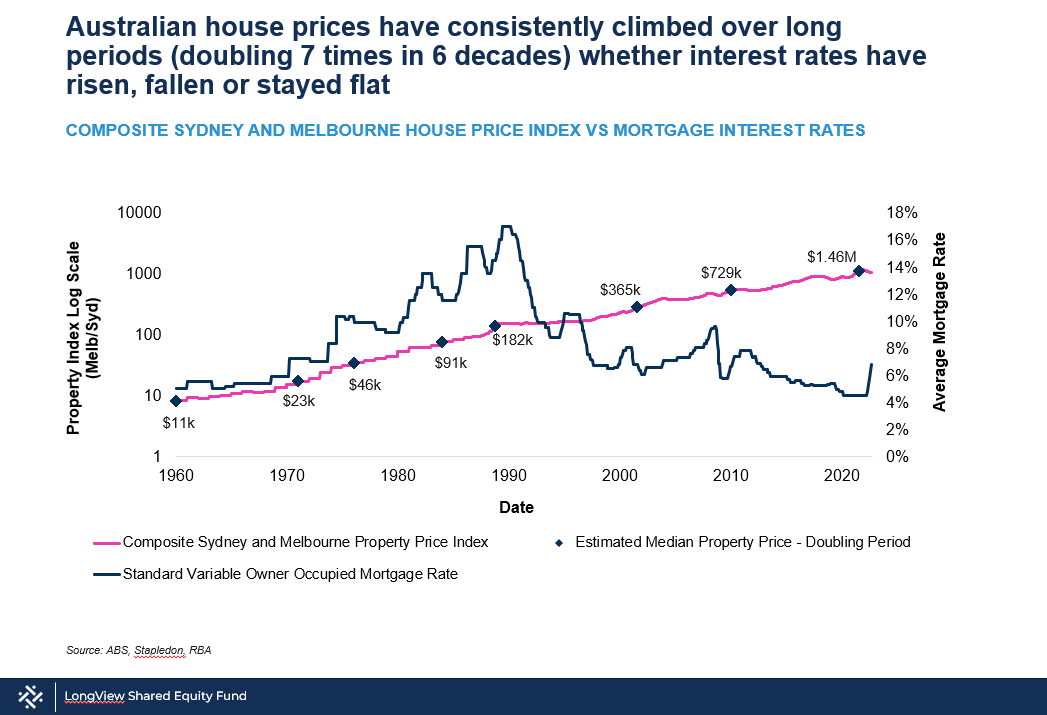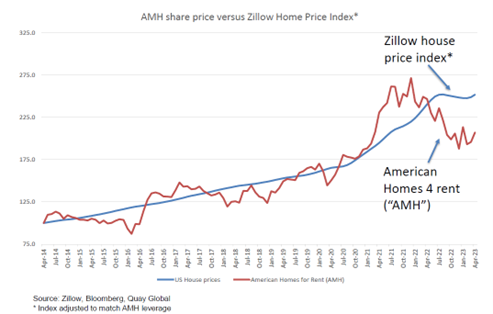Is now a good time to buy a house?
Australians love the idea of property ownership. It’s more than a matter of shelter, it’s a national pastime. Australian residential property prices are down 6.8% on an annual basis according to CoreLogic’s Home Value Index. That’s a slight recovery, but are prices still at a level that might prompt prospective buyers to try and score a bargain?
There are a few questions at play here.
As interest rates continue to rise in the battle to reign in inflation, could we see firesales and further falls in prices?
Or, will housing shortages exacerbated by returning immigration see housing prices rebound to previous highs?
It’s not a simple story, and given it requires taking a crystal ball approach to prediction, unsurprisingly there isn’t consensus on what comes next. So, taking into account uncertainty, I've asked a few industry insiders what they believe prospective buyers need to think about currently.
- Diana Mousina, AMP senior economist
- Evan Thornley, Longview’s executive, and
- Chris Bedingfield, Quay Global Investors’ principal and portfolio manager.
%20(1600%20%C3%97%20595%20px).png)
What’s happening right now in property markets?

The only parts of Australia to see gains in the last 12 months have been Western Australia and South Australia.
The Western Australian market has had low supply and high demand in terms of property. Given the economy within the state is heavily linked to mining, it has benefited from spiking commodity prices and the need for new mines to fulfil demand ranging from coal to green metals like lithium.
The South Australian housing market has benefited from a generally lower cost of living for the state, appealing to those looking to migrate within Australia and seen as good value for interstate investors. There’s also been investment in infrastructure, such as a global tech hub at Lot Fourteen which has had state government support in investment.
Across broader Australia though, there has been improvement in dwelling values in the past few months, though not enough to recapture the value lost in falls since the start of 2022.
There’s still high demand in the low supply – and we are currently facing a rental crisis.

Mousina notes that there isn’t likely to be an improvement in supply any time soon, with dwelling approvals and construction significantly down on previous years – and immigration on the upward path.


The outlook for property markets
Mousina expects markets to be flat to slightly up on the year. Given we’ve seen some gains this year, this means there will some further downside in the second half of 2023.
“The RBA is likely to take rates higher than people were expecting. I think a lot of momentum in the housing market has been buyers having the expectation that we’re close to the end of the interest rates hiking cycle, but it doesn’t look like we’re there,” says Mousina.
She notes that the tight rental market has also pushed people into buying.
“All the economic indicators tell us growth is going to slow from here. Unemployment rates are going to go up and the RBA is likely to hike rates again. That indicates to me that there has to be further downside to home prices from current levels,” she says.
Thornley notes that regardless of short-term activity, residential property grows over the longer term due to Australia’s population growth and concentration.
“Existing residential is a remarkably stable asset class, so despite the screaming headlines and frequent predictions of doom and gloom, it has steadily grown for 100 years at about 7% pa. It doubles on average every 10 years,” he says.

He anticipates that the trend will continue.
“The supply of suburban land is fixed, the population wanting well-located land (with homes on it) continues to rise – hence steady long-term growth.”
Bedingfield is similarly positive about the long-term prospects for residential property but sees opportunities in the short term too.
“We are bullish on residential as the sharp increase in interest rates have (predictably) resulted in an equally sharp decline in dwelling approvals and starts. The ongoing demand supply imbalance is likely to offset the headwinds of rising interest rates, although we caution there may be some distressed selling as high mortgage rates bit,” says Bedingfield.
He is focused on established homes and apartments rather than listed developers for exposure.
Don’t forget the other sides of property
It’s easy to forget that residential property isn’t the complete story and it’s a mixed picture for the other sides of the property market.
Bedingfield likes retail property, despite the risk of an economic downturn.
“For most businesses selling retail products, purely online does not scale, and physical stores continue to be profitable. We see tenant demand surging globally,” he says.
He’s more cautious on industrial property which is experiencing significant demand at this point. This is encouraging new supply so Bedingfield anticipates some deceleration in rental growth here as supply starts to hit.
Mousina expects industrial property to continue to see some upside in the short-term while anticipating some downward pressure in retail off the back of inflationary pressures and rising interest rates. She views commercial property as a key area of concern.
“The vacancy rates for some commercial properties are quite evaluated. There’s a risk that evaluations will need to come down more because it doesn’t look like work-from-home trends have been factored in. Some valuations still speak to people coming back 3-4 days to the office, while the reality is 1-2 days,” she says.
Is now the time to buy property?
To put it simply, none of the experts would stand in the way of someone ready and able to buy – and with a need for shelter.
As Mousina puts it, “there will always be turnover in the housing market because people need somewhere to live. It’s a fundamental need. If you need somewhere to live, you can meet the repayments and have the borrowing capacity to do it, then you might still buy.”
She views it as riskier from an investment perspective though.
“There are downside risks to growth and likelihood of recession that means you could take a hit. There are lower-risk options that can give you the same or similar returns at the moment,” she says.
That said, she says negatively geared properties are likely to be attractive for investors at the moment because interest rates have gone up.
On the surface, Thornley suggests now isn’t a bad time to buy – though he argues focusing on market timing is the wrong approach for property.
“Now is a better time to buy than say 18 months ago and those laughable predictions of 20-30% crashes in housing prices. This simply doesn’t happen in Australia. Residential property is only 23% geared as an asset class so is much less volatile than the predictions of bank economists. But the issue is not what the market will do in the next 6 or 12 months, it’s what your individual properties will do over the next decade,” says Thornley.
Similarly, Bedingfield takes a 3-5 year view on residential property to view it as a good time to buy.
“The collapse in new dwelling supply will continue to worsen Australia’s housing shortfall. Demand is not only being driven by immigration but also demographics as Generations Y and Z continue to add to household formation, driving long-term rents and values,” he says.
Both Bedingfield and Thornley are keen advocates on the fundamentals of individual properties, rather than flinging the investment net too wide.
“It matters MUCH more WHAT you buy rather than when you buy it. The average capital growth across the housing market is 7% pa and there is massive variation at the individual property level. What matters more than anything else is asset selection.
Buying the right property will have a higher magnitude of impact on your returns over a decade hold than when you bought it,” Thornley says.
What properties should you buy in the current market?
Bedingfield is overweight both residential (stand-alone homes) and self-storage in the current market.
“Both sectors have favourable demand and supply outlooks, tend to be recession resilient and the listed prices have materially disconnected to underlying fundamentals. A good example is AMH (NYSE: AMH) (listed US housing), versus the house price index (Zillow). Like Australia, the US housing market has turned, prices are rising, and AMH is priced at a significant discount to the market,” he says.

“These are low volatility markets (compared to say Perth) and these older dwellings usually have a price history for 50-100 years to give you confidence on capital growth history. Put another way, we buy “dirt disguised as houses” – where our target is 80% of the purchase price is actually in the land under the home. That’s the money that will appreciate in value as population pressure continues its century-long march on land values,” he says.
Mousina suggests investors looking for yield to consider some of the regions.
“Find regional spots where you think there’ll be a good growth story for jobs, or they have a high share of essential workers and a good education sector. You’ll get constant population growth and constant return. Make sure the area isn’t a high risk for natural disasters, like fire or floods,” she says.
On the whole, though, Mousina suggests those looking for investments might find better opportunities in the share market or fixed income where they might find rallies down the track or downside protection from recessionary risks.
2 topics
1 stock mentioned
2 contributors mentioned

